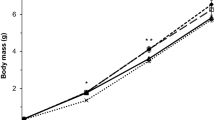Abstract
HYPERACTIVITY induced by exposure to a pesticide could be a disadvantage to an organism in the wild1–5, particularly by increasing the risk of predation. I have therefore investigated whether warty newts (Triturus cristatus) will preferentially prey on hyperactive, DDT-treated tadpoles of the common frog (Rana temporaria) rather than untreated tadpoles.
Similar content being viewed by others
References
Davis, B. N. K., J. Appl. Ecol., 3 (Suppl.), 133 (1966).
Warner, R. E., Petersen, K. K., and Borgman, L., J. Appl. Ecol., 3, (Suppl.), 223 (1966).
Isaacson, P. A., Curr. Sci., 18, 530 (1968).
Dustman, E. H., and Stickel, L. F., Ann. NY Acad. Sci., 160, 162 (1969).
Cooke, A. S., Environ. Pollution, 1, 57 (1970).
Taylor, A. C, and Kollros, J. J., Anat. Rec., 94, 7 (1946).
Smith, M., The British Amphibians and Reptiles, fourth ed. (Collins, London, 1969).
Cooke, A. S., and Fulford, W. G., Brit. J. Herpetol. (in the press).
Meuller, H. C., Nature, 217, 92 (1968).
Author information
Authors and Affiliations
Rights and permissions
About this article
Cite this article
COOKE, A. Selective Predation by Newts on Frog Tadpoles treated with DDT. Nature 229, 275–276 (1971). https://doi.org/10.1038/229275a0
Received:
Issue Date:
DOI: https://doi.org/10.1038/229275a0
- Springer Nature Limited
This article is cited by
-
Assessing predator-prey interactions in a chemically altered aquatic environment: the effects of DDT on Xenopus laevis and Culex sp. larvae interactions and behaviour
Ecotoxicology (2019)
-
Searching for Black Holes in Space
Space Science Reviews (2014)
-
Cholinesterase activities and behavioral changes in Hypsiboas pulchellus (Anura: Hylidae) tadpoles exposed to glufosinate ammonium herbicide
Ecotoxicology (2013)
-
Sublethal effects of atrazine on embryo-larval development of Rhinella arenarum (Anura: Bufonidae)
Ecotoxicology (2012)
-
Extracts of the invasive shrub Lonicera maackii increase mortality and alter behavior of amphibian larvae
Oecologia (2011)





